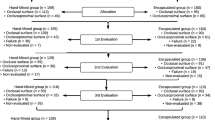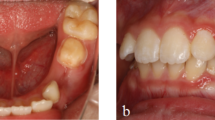Abstract
AIM: This was to prospectively investigate the success and median survival rate of band and loop space maintainers using glass ionomer luting cement for attachment. METHODS: A total of 40 children (22 females and 18 males) between the ages of 3.4 and 7.3 years participated in the study. Each patient received only one band and loop space maintainer. For each child, the same paediatric dentist carried out all diagnosis, band selection, and impression taking and appliance cementation. The same dental technician fabricated all appliances. The luting cement used was Ketac™-Cem-Maxicap™. Regular follow up appointments were scheduled at 4–6 months intervals. Variables, which might have affected the median survival time for the appliances were tested using Log-Rank and Chi-square tests. RESULTS: 40% of the band and loop space maintainers were successful and 57.5% failed during the study period (40 months). The most common cause of failure was decementation (82% of all failed cases). The overall median survival time was 19.9 months. Appliances fitted in the maxillary and mandibular left side of the mouth showed a statistically higher survival rate than those fitted in the right side (maxillary left quadrant = 35 months, mandibular left quadrant = 28 months, maxillary right quadrant =14 months, mandibular right quadrant = 16 months) (pS < 0.008). CONCLUSIONS: Although the overall median survival time was clinically acceptable(19.9 months), the failure rate of the band and loop space maintainers in general was high (57.5%). The main reason for failure was decementation of the band. Further studies are required to compare glass ionomer cements with more recent resin modified luting cements.
Similar content being viewed by others
References
Baroni C, Franchini A, Rimondini L. Survival of different types of space maintainers. Pediatr Dent 1994;16:360–361.
Brown RA, Swanson Beck J. Survival analysis. In: Brown RA, Swanson Beck J (eds). Medical statistics on personal computers. London: BMJ Publishing Group, 1995: 99–118.
Christensen JR, Fields HW Jr. Space maintenance in the primary dentition. In: Pinkham JR, Casamassimo PS, Fields HW Jr, McTigue DJ, Nowak AJ (eds). Pediatric Dentistry: infancy through adolescence. Mussouri: Elsevier Saunders, 2005: 419–448.
Creanor SL, Carruthers LM, Saunders WP, Strang R, Foye RH. Fluoride uptake and release characteristics of glass ionomer cements. Caries Res 1994;28:322–328.
Croll TP. Cementation of stainless steel space maintainers. J Pedod 1983;7:120–126.
Cutler SJ, Ederer F. Maximum utilization of the life table method in analyzing survival. J Chron Dis 1958;8:699–712.
Durning P, McCabe JF, Gordon PH. A laboratory investigation into cements used to retain orthodontic bands. Br J Orthod 1994;21:27–32.
Fathian M, Kennedy DB, Nouri MR. Laboratory-made space maintainers: a 7-year retrospective study from private pediatric dental practice. Pediatr Dent 2007;29:500–506.
Hill CJ, Sorenson HW, Mink JR. Space maintenance in a child dental care program. J Am Dent Assoc 1975;90:811–815.
Hotz P McLean JW, Sced I, Wilson AD. The bonding of glass ionomer cements to metal and tooth substrates. Br Dent J 1977;142:41–47.
Kirzioglu Z, Ozay MS. Success of reinforced fiber material space maintainers. J Dent Child 2004;71:158–162.
Millett DT, Glenny AM, Mattick CR, Hickman J, Mandall NA. Adhesives for fixed orthodontic bands. Cochrane Database Syst Rev 2007; 18: CD004485. DOI: 10.1002/14651858.
Millett DT, Gordon PH. The performance of first molar orthodontic bands cemented with glass ionomer cement—a retrospective analysis. Br J Orthod 1992;19:215–220.
Millett DT, McCabe JF, Bennett TG, Carter NE, Gordon PH. The effect of sandblasting on the retention of first molar orthodontic bands cemented with glass ionomer cement. Br J Orthod 1995;22:161–169.
Moore TR, Kennedy DB. Bilateral space maintainers: A 7-year retrospective study from private practice. Pediatr Dent 2006;28:499–505.
Qudeimat MA, Fayle SA. The longevity of space maintainers: a retrospective study. Pediatr Dent 1998;20:267–272.
Rajab LD. Clinical performance and survival of space maintainers: Evaluation over a period of 5 years. J Dent Child 2002;69:156–160.
Santos VL, Almeida MA, Mello HS, Keith O. Direct bonded space maintainers. J Clin Pediatr Dent 1993;17:221–225.
Tulunogu O, Ulusu T, Genc Y. An evaluation of survival of space maintainers: a six-year follow up study. J Contemp Dent Pract 2005;6:74–84.
Author information
Authors and Affiliations
Corresponding author
Rights and permissions
About this article
Cite this article
Sasa, I.S., Hasan, A.A. & Qudeimat, M.A. Longevity of Band and Loop Space Maintainers Using Glass Ionomer Cement: A Prospective Study. Eur Arch Paediatr Dent 10, 6–10 (2009). https://doi.org/10.1007/BF03262659
Published:
Issue Date:
DOI: https://doi.org/10.1007/BF03262659




